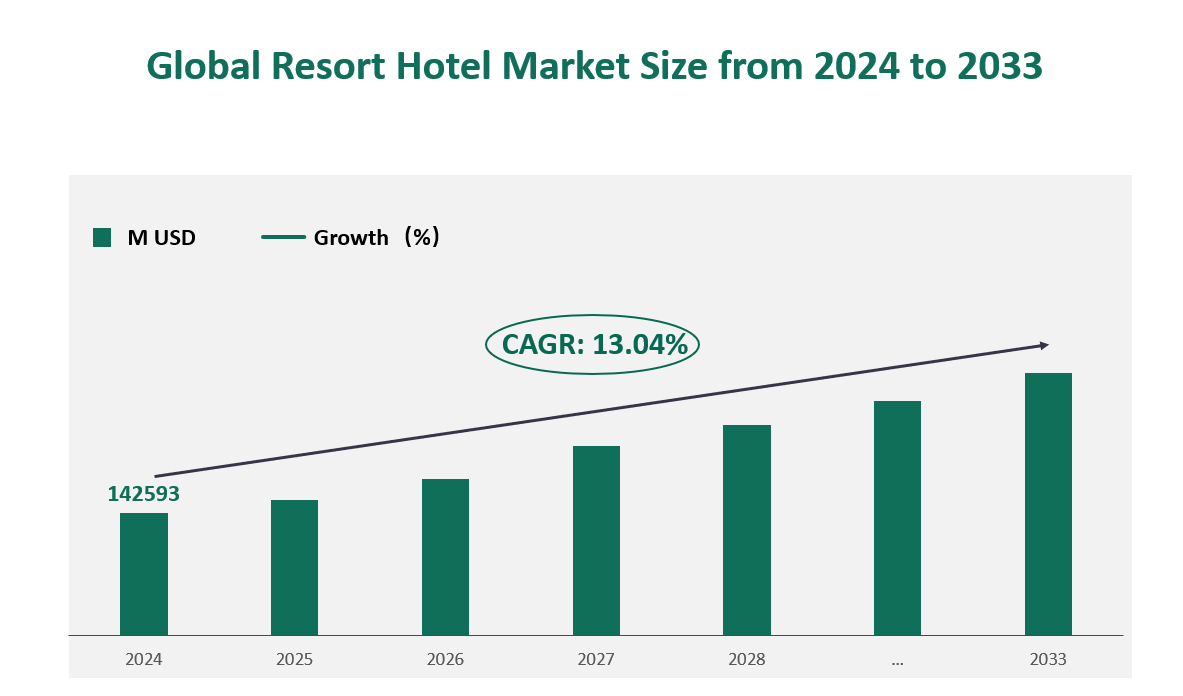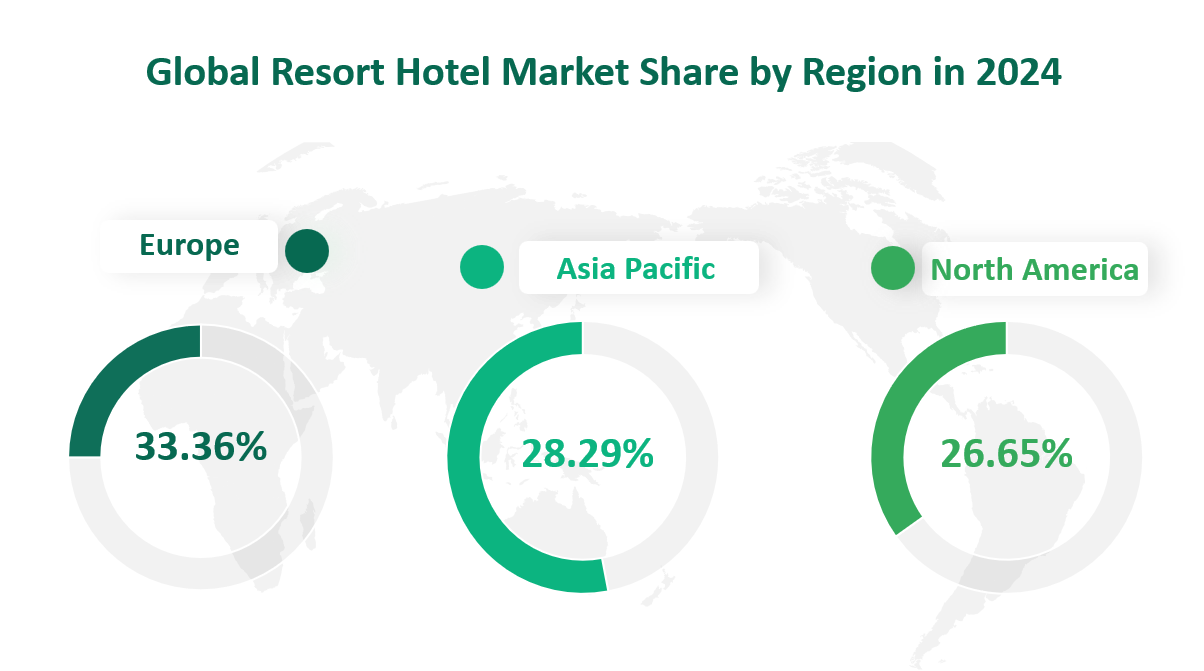1 Global Resort Hotel Market Size (Revenue) and CAGR (2024-2033)
Global Resort Hotel market generated revenue of USD 142593 Million in 2024 with a CAGR of 13.04% during 2024 to 2033.
The Compound Annual Growth Rate (CAGR) from 2024 to 2033 is projected to be 13.04%. This growth rate indicates a robust expansion of the resort hotel market over the next few years. The CAGR calculation is based on the market’s total value in 2024. This growth is expected to be fueled by several key drivers, including the increasing popularity of luxury and all-inclusive resort options, the rise in disposable incomes among middle-class consumers, and the growing trend of digitalization in the hospitality industry.
Figure Global Resort Hotel Market Size (M USD) Outlook (2024-2033)

2 Resort Hotel Emerging Market Trends
Travelers want an extraordinary digital experience tailored to their needs. User-friendly design is listed as an important factor of unforgettable online experience, which means that users can easily and intuitively accomplish what they want. Travelers visit the destination website to get information about accommodation, tourist attractions, things to do and restaurant recommendations. Ultimately, customers value seamless Omni-channel experience, combining innovative, adaptable and convenient digital experience with personalized and seamless face-to-face experience. This trend will promote resort operators to change to digital resort solutions, provide digital experience for customers, and thus enhance the brand’s influence.
3 Global Resort Hotel Market by Type in 2024
The global resort hotel market is segmented into three primary product types: high-end hotel accommodation, medium-end hotel accommodation, and low-end hotel accommodation.
High-End Hotel Accommodation
High-end hotel accommodation refers to luxury resorts with nightly rates exceeding $450. These resorts are characterized by their premium services, exclusive amenities, and often, unique locations such as private beaches, mountain retreats, or historic sites. In 2024, the high-end segment accounted for a substantial portion of the market, with a revenue of $57,908 million USD. This segment held the largest market share, reflecting its appeal to affluent travelers seeking unparalleled experiences. High-end resorts often feature personalized services, world-class dining options, and state-of-the-art facilities, making them a preferred choice for both leisure and business travelers.
Medium-End Hotel Accommodation
Medium-end hotel accommodation includes resorts with nightly rates ranging between $200 and $450. These resorts offer a balance of affordability and luxury, targeting middle-class travelers and families. In 2024, the medium-end segment recorded a revenue of $54,120 million USD. While slightly behind the high-end segment in terms of market share, medium-end resorts have been experiencing a robust growth rate. This segment’s appeal lies in its ability to provide quality services and amenities at a more accessible price point, making it a popular choice for a broader range of consumers.
Low-End Hotel Accommodation
Low-end hotel accommodation consists of budget-friendly resorts with nightly rates below $200. These resorts prioritize affordability and basic amenities, catering to budget-conscious travelers and young tourists. In 2024, the low-end segment generated a revenue of $30,564 million USD. Although it holds the smallest market share, this segment has been growing at a significant rate, driven by the increasing demand for budget travel and the expansion of the global middle class.
Table Global Resort Hotel Market Size and Share by Type in 2024
Product Type | Market Size (M USD) | Market Share (%) |
|---|---|---|
High-end Hotel Accommodation | 57,908 | 40.62 |
Medium-end Hotel Accommodation | 54,120 | 37.95 |
Low-end Hotel Accommodation | 30,564 | 21.43 |
Total | 142,593 | 100.0 |
4 Global Resort Hotel Market by Application in 2024
The global resort hotel market is further segmented based on its applications, primarily categorized into leisure and business travel.
Leisure Travel
Leisure travel refers to resort hotel stays aimed at relaxation, entertainment, and exploration. This segment includes family vacations, honeymoon trips, and adventure tourism. In 2024, the leisure travel segment accounted for the majority of the market, with a revenue of $111,171 million USD. This segment’s dominance is attributed to the growing trend of experiential travel, where consumers seek unique and memorable experiences. Leisure travelers often prioritize locations with natural beauty, cultural attractions, and a wide range of activities, making resort hotels an ideal choice.
Business Travel
Business travel, on the other hand, involves stays for corporate events, conferences, and professional meetings. This segment is characterized by its focus on convenience, accessibility, and professional services. In 2024, the business travel segment generated a revenue of $31,422 million USD. While smaller in market share compared to leisure travel, the business segment has been growing steadily, driven by the increasing globalization of business activities and the need for high-quality accommodation options.
Table Global Resort Hotel Market Size and Share by Application in 2024
Application | Market Size (M USD) | Market Share (%) |
|---|---|---|
Leisure | 111,171 | 77.96 |
Business | 31,422 | 22.04 |
Total | 142,593 | 100.0 |
5 Global Resort Hotel Market by Region in 2024
In 2024, the global resort hotel market witnessed significant growth across various regions, driven by the recovery of the travel and tourism industry following the COVID-19 pandemic. The market dynamics varied by region, influenced by factors such as economic development, consumer preferences, and the availability of leisure and business travel opportunities.
Asia-Pacific The Asia-Pacific region emerged as the largest market for resort hotels in 2024, with a revenue of $47572 million USD. This region’s dominance can be attributed to its vast and diverse tourism offerings, ranging from luxury beach resorts in Bali and Phuket to cultural and historical attractions in China and Japan. The region’s growth was further fueled by the rising middle class, increasing disposable incomes, and the expansion of domestic and international travel. Countries like China and Japan played a pivotal role, with China’s growing domestic tourism market and Japan’s reputation for high-quality hospitality services.
North America North America, comprising the United States, Canada, and Mexico, recorded a revenue of $40,338 million USD in 2024. The region’s resort hotel market was driven by the United States, which attracted millions of international tourists annually. Popular destinations such as Florida, Hawaii, and California contributed significantly to the market’s growth. Additionally, the region benefited from a strong domestic travel market, particularly in the United States, where leisure travel remained a popular choice for consumers. Canada and Mexico also contributed to the market’s expansion, with Mexico’s beach resorts and Canada’s natural attractions drawing a steady stream of visitors.
Europe Europe’s resort hotel market generated a revenue of $37,994 million USD in 2024. The region’s appeal lay in its rich cultural heritage, historical landmarks, and diverse natural landscapes. Countries such as Spain, Italy, France, and Greece were key drivers, with their Mediterranean coastlines and historic cities attracting a significant number of tourists. The region also benefited from the growing trend of experiential travel, where travelers sought unique and immersive experiences. The recovery of the European economy and the easing of travel restrictions further boosted the market’s performance.
South America South America’s resort hotel market saw a revenue of $9,124 million USD in 2024. While smaller in comparison to other regions, South America’s market exhibited a robust growth rate. Brazil, Argentina, and Colombia were the primary contributors, with Brazil’s vibrant cities and natural attractions like Rio de Janeiro and the Amazon rainforest drawing significant attention. The region’s growth was driven by the increasing popularity of eco-tourism and adventure travel, as well as the growing middle class in countries like Brazil and Argentina.
Middle East & Africa The Middle East and Africa region recorded a revenue of $7,564 million USD in 2024. The region’s growth was driven by the United Arab Emirates (UAE) and South Africa, with the UAE’s luxury resorts and South Africa’s diverse tourism offerings contributing significantly to the market. The region’s appeal lay in its unique cultural experiences, luxury hospitality, and natural attractions such as the African savannas and the Arabian deserts. The growth of the region was also supported by investments in infrastructure and the development of new tourism projects.
Table Global Resort Hotel Market Size, Region Wise in 2024
Region | Market Size (M USD) | Market Share (%) |
|---|---|---|
Asia-Pacific | 40338 | 28.29% |
North America | 37994 | 26.65% |
Europe | 47572 | 33.36% |
South America | 9124 | 6.40% |
Middle East & Africa | 7564 | 5.30% |
Total | 142,593 | 100.00% |
Figure Global Resort Hotel Market Share, Region Wise in 2024

6 Global Resort Hotel Market Top 3 Players
Company Introduction and Business Overview: Marriott International, Inc. is a leading multinational hospitality company headquartered in Bethesda, Maryland, USA. Founded in 1927, Marriott operates a portfolio of over 8,100 properties across 30 hotel brands in 139 countries and territories. The company is renowned for its luxury and premium brands, including Ritz-Carlton, JW Marriott, and Marriott Hotels.
Products Offered:
- Ritz-Carlton: Known for its luxury resorts and hotels, offering unparalleled service and amenities.
- JW Marriott: Focused on providing high-end, personalized experiences in both urban and resort settings.
- Marriott Hotels: Catering to business and leisure travelers with a balance of comfort and functionality.
Revenue in 2022: Marriott’s revenue in 2022 reached $2143 million USD, making it the largest player in the resort hotel market. The company’s success can be attributed to its diverse portfolio, strong brand presence, and strategic acquisitions.
Company Introduction and Business Overview: MGM Resorts International is a global hospitality and entertainment company headquartered in Paradise, Nevada, USA. Founded in 1986, MGM Resorts operates destination resorts in key locations such as Las Vegas, Massachusetts, Detroit, and Mississippi. The company is known for its iconic properties, including Bellagio, Mandalay Bay, and MGM Grand.
Products Offered:
- Luxury Resorts: Such as Bellagio and Mandalay Bay, offering high-end accommodations, world-class dining, and entertainment options.
- Casino Resorts: Combining gaming with luxury accommodations, providing a comprehensive entertainment experience.
- All-Inclusive Resorts: Offering inclusive packages that cater to families and leisure travelers.
Revenue in 2022: MGM Resorts International recorded a revenue of $1950 million USD in 2022. The company’s growth was driven by its strong presence in Las Vegas and its strategic expansion into new markets through acquisitions and partnerships.
Company Introduction and Business Overview: Hilton Worldwide Holdings Inc. is a multinational hospitality company headquartered in McLean, Virginia, USA. Founded in 1919, Hilton operates a diverse portfolio of hotel brands across various market segments. The company is known for its commitment to quality and innovation, offering a wide range of services and amenities to its guests.
Products Offered:
- Luxury Brands: Such as Waldorf Astoria Hotels & Resorts and Conrad Hotels & Resorts, offering premium experiences.
- Premium Brands: Including Hilton Hotels & Resorts and DoubleTree by Hilton, catering to business and leisure travelers.
- Budget Brands: Such as Hampton by Hilton and Motto by Hilton, providing affordable accommodation options.
Revenue in 2022: Hilton’s revenue in 2022 reached $1694 million USD. The company’s success can be attributed to its diverse brand portfolio, strong global presence, and focus on customer satisfaction. Hilton’s strategic acquisitions and partnerships further strengthened its position in the market.
Table Global Resort Hotel Revenue of Top3 Players in 2022
Company | 2022 |
Marriott | 2143 |
MGM Resorts International | 1950 |
Hilton | 1694 |

